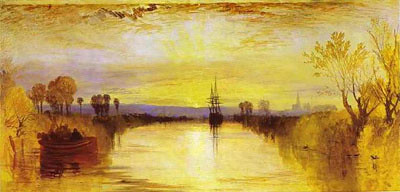
J. M. W. Turner's painting: "Chichester Canal." Turner's brilliant sunsets may reflect vivid skies caused by volcanic ash.
Redstate [click to read] offers a great compilation of 'scientific observation' all the way back to the Nineteenth Century!
The most amazing weather event of the Nineteenth Century has to be 1816, the "year without a Summer."
In 1815, volcanic Mount Tambora erupted on the island of Sumbawa, Indonesia, sending tons of volcanic ash into the atmosphere. The result was a period when the sunset skies were particularly beautiful. J. M. W. Turner captures this in his paintings from that time. The following Summer would prove to be most unusual in Europe and North America.
In the Spring of 1816 a 'persistant dry fog' was observed in the skies. When crops were planted in May, they fell victim to frost. In June, snow was still falling in New York state and Quebec had a foot of it. Frozen rivers and lakes were observed well into August in Pennsylvania.
The result was a food shortage of epic proportions. Britian and Ireland saw famine, as did the Northern portion of the United States. Food prices soared and the people struggled to bring food in on America's minimal road system. Even as far away as China, trees and water buffalo were killed by extreme temperatures and flooding destroyed crops.
The following Winter was also severe. New York's Upper Bay froze. You could drive a sleigh on the ice from Manhattan to Governor's Island.
Gradually the normal patterns of climate and seasons returned. Today the 'Year without a Summer' is a little-known chapter in a long history.




No comments:
Post a Comment